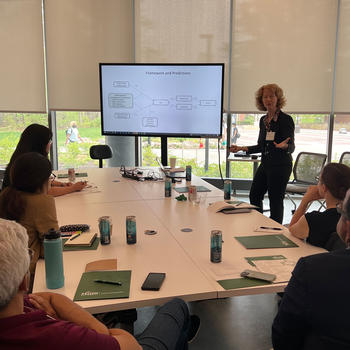In This Story
For most people, the term “marketing” is mainly associated with selling products. For academics specializing in the field, however, marketing means something both simpler and much more complex -- the science of communicating value. While sales and advertising are common contexts, marketing can also be seen and studied as a general feature of virtually all competitive environments.
Marketing scholarship, then, is an inherently diverse field, producing insights that often reverberate and cross-pollinate across domains. Each context has the potential to reveal something new and surprising about the fundamental issues that drive market behaviour.

This diversity was on full display during the annual Marketing Research Symposium held by George Mason University School of Business on Friday, April 14. Mason marketing faculty were joined by illustrious colleagues from other universities to share research in progress and exchange ideas.
Representing the School of Business as presenters at the symposium were Jiyeon Hong and Sharaya Jones, both assistant professors of marketing. Hong shared research suggesting that in the field of non-profit, the content and writing style of thank-you notes influence donors’ future behavior. Specifically, Hong and her colleagues focus on gratitude expression (e.g, “Thank you, I’m grateful”) and impact statement (e.g., “You have helped…, Your generous donation made possible”). Through their analysis of a large set of thank-you notes, an excessive use of gratitude expressions was detrimental to donor engagement, while emphasizing the donor's impact at the beginning of the letter improves effectiveness. Hong's research provides practical insights for writing better thank-you letters by analyzing their linguistic features.
Jones’s research concerns one of the most awkward consumer dilemmas – that feeling when you have to make buying decisions on behalf of at least one other person. Deciding what to bring for a potluck, or what snacks to serve for movie night with friends, would be recognizable examples. As you might expect, Jones finds that people are more anxious during these joint-consumption scenarios than for gift-giving or buying for oneself, especially when they don’t know their co-consumer’s preferences beforehand or are aware that those preferences clash with their own. Consequently, they tend to hedge their bets by going for assortment options that promise “something for everyone” – a choice that could well be of interest to product marketers at CPG companies.
Kusum Ailawadi, the Charles Jordan 1911, TU’12 Professor of Marketing at Dartmouth University, presented research that challenges received wisdom in the retail industry. Dual branding – that is, supplying both national and retailer-exclusive brands (also known as “private label” brands) – is often believed to be detrimental for national brand manufacturers. But based on comprehensive sales data from grocery stores in Spain, Ailawadi comes to a more nuanced conclusion. She finds, for example, that manufacturers with high market share are more apt to supply private label than are premium-brand manufacturers. Also, Ailawadi’s analysis points to a “reciprocity effect” whereby retailers give valuable shelf space to the national brands of their private label suppliers.
Appearing on Zoom at the symposium, Susan Broniarczyk, Associate Dean for Research and John L. Adams Endowed Chair in Business at University of Texas-Austin, walked attendees through a forthcoming paper about how sharing online content, even without reading it, makes people feel smarter. Although this “subjective knowledge” is not backed up by any actual learning, Broniarczyk finds it can sway our most weighty decisions: Study participants who shared investment advice on Facebook took greater financial risks in a subsequent retirement planning simulation.
Finally, Christine Moorman, the T. Austin Finch Sr. Professor of Business Administration at Duke University, presented her work on how strong brands compete in the labor market. High-quality brands have been known to pay lower salaries in general, on the theory that talents will accept less money in exchange for the privilege of working for such a prestigious employer. But Moorman finds that premium brands that exert this leverage against employees are less profitable than their peers, due to reduced productivity and employee retention. On the other hand, brands with a more niche identity that pay higher salaries to employees with brand-appropriate qualities enjoy increased profits.
Jessica Hoppner, chair of the marketing area at George Mason University School of Business, says, “Our Marketing Research Symposium aims to bring together renowned guest speakers with scholars from across the region, creating a vibrant atmosphere of knowledge sharing, networking, and transformative insights. This year’s symposium sparked conversations, and hopefully collaborations, that promise to drive marketing strategy research forward.”
Recent journal publications from Mason marketing faculty include: “Writing More Compelling Creative Appeals: A Deep Learning-Based Approach,” co-authored by Jiyeon Hong, Marketing Science; “Economic policy uncertainty and shareholder wealth: the role of marketing, operations and R&D capabilities”, co-authored by Saurabh Mishra, Journal of the Academy of Marketing Science; and “Raw Ideas in the Fuzzy Front End: Verbosity Increases Perceived Creativity”, co-authored by Sharaya Jones, Marketing Science.
